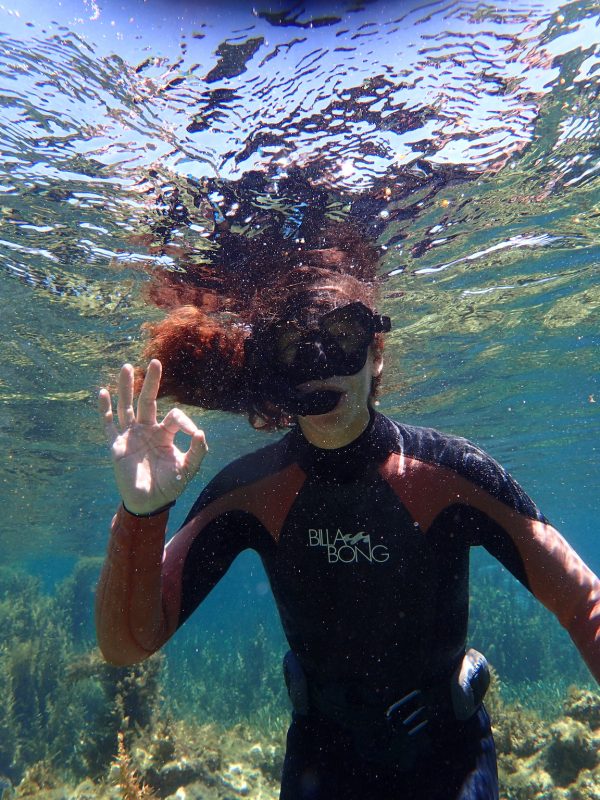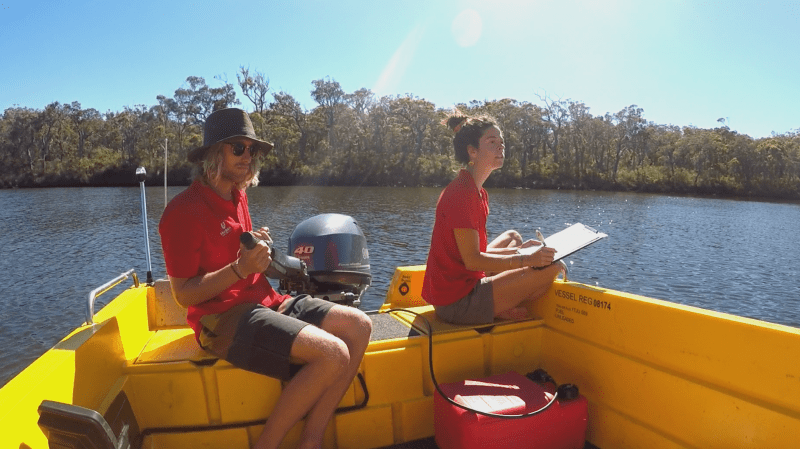Talking bait use with researcher Dr. Clara Obregón
Dr Clara Obregón, a PhD graduate of Murdoch University who hails from Menorca, Spain, was a co-investigator on the Tuna Australia report looking at alternative bait options. Tuna Australia spoke with Clara about the report findings, her PhD thesis, and her favourite seafood dish (which won’t surprise you!).
Can you tell us a bit about yourself?
I come from Menorca, a small Spanish island in the Mediterranean Sea. But my career as a marine scientist started in Belgium, during a lecture on the current issues of artisanal tuna fisheries at the Université Catholique de Louvain. That one-hour class changed my career path. I am still as moved and fascinated by small-scale fisheries as I was back then, and I always aim to transmit that through my work.

Clara Obregón doing underwater research in in Rottnest Island, Western Australia.
You've worked in fisheries conservation and research in Spain, Mexico, Madagascar, London and now Australia. What's been your best memory from this work?
Every new place has different cultures, languages, and environments and, at the same time, similar concerns, issues, and ways of bypassing barriers. This realisation made the “moving out” and “moving in” a much easier process.
Another thing is the amazing, passionate, and kind people, from different backgrounds and with different motivations, that I have met on the way. They have made my day-to-day work much easier, and the experience much more enjoyable. Most of my good memories are these people.
Can you tell us about the bait use report and share some of the key findings?
Recently, Tuna Australia (TA) produced a research report looking at bait usage in the Eastern Tuna and Billfish Fishery (ETBC), which was made possible by a grant from the Marine Stewardship Council (MSC) Science and Research Fund. The main goal was to support TA members operating in the MSC-certified ETBF to better understand the sustainable bait landscape. Tuna Australia also investigated the perceptions of fishers and suppliers regarding alternative bait options as well as the potential for artificial baits to be incorporated into the fishery.
The report found that there are several alternative bait options, including different sources of the Argentine shortfin squid (Illex argentines), which combined with current sourcing practices could reduce the pressure on this species, and reduce the cost of bait for commercial fishers and suppliers.
Were there any surprising findings?
Personally, I found two things quite surprising.
Firstly, sourcing bait is such a complex activity. Securing bait involves many considerations for the tuna industry as the bait is caught during a specific season, depending on the region, and must be bought ahead of time (often one year ahead) and stored to support the fishery later on. This is to maximise access to the correct size baits at the best available price. In addition to that, there are market-led squid costs, which affects the availability of squid bait. This is a massive investment for industry. Once suppliers get hold off the bait, there are also biosecurity issues around importing squid which are highly restrictive.
Secondly, there is little literature available regarding the sustainability of squid bait, its governance and potential alternatives for fisheries. I think this is an important information gap and will become more so as provenance of sustainable bait becomes a more important issue.

Kurt Krispyn and Clara Obregón doing boat-to-boat survey work in the Blackwood River, Augusta (WA) in 2019.
You recently completed your PhD at Murdoch University, Western Australia (WA). What was your thesis on and what did you find?
My thesis focused on the blue swimmer crab fisheries on the south coast of WA. I mainly focused on shining a light on the social aspect of these fisheries.
This research project tackled questions like “What are fishers concerned about? What are their perceptions on the blue swimmer crab fishery management?” and looked at the communication between all stakeholders. The research findings highlighted differences and similarities between the perceptions of commercial and recreational fishers targeting blue swimmer crabs in the region. It also identified communication barriers between different stakeholders. For example, different stakeholders intuitively communicate through different forms; fishers naturally prefer face-to-face interaction while managers and scientists tend towards electronic communication.
I also looked at historical information on the fishery from newspapers (since the early 1900s) and combined it with these perceptions. Both data sources showed that blue swimmer crabs in the Peel-Harvey estuary, home to the blue swimmer crab, have significantly decreased with time, and highlighted the value of considering local fisher knowledge, in fisheries governance.
Now your PhD is complete, what are you planning to do next?
I used to think about a lot about “what next” but right now I am very happy with what I am doing. I work part-time for bio.inspecta Pty Ltd, a conformity assessment body that assesses fisheries against the MSC standard for sustainable fisheries. On my other days, I focus on research projects such as the work with Tuna Australia and Murdoch University. I hope that whatever I do, I will keep learning about sustainable governance of fisheries at local and global scales, collaborating with different stakeholders, and of course, meeting fantastic people along the way!
What's your favourite way to cook or enjoy seafood?
I am from the Mediterranean and, as you know, we love seafood there! My favourite way of eating seafood is in paella. Seafood paella is a Spanish rice dish, made in a big “paella pan” where the rice, the spices and different types of seafood are slow-cooked. It is not only delicious, but it is naturally meant to be shared, which is the best bit!